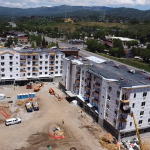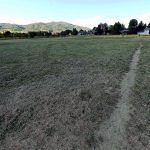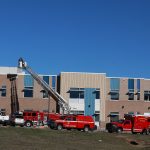Former Brown Ranch consultant responds to housing authority soils memo
Refined study recommended in conjunction with revised master plan for affordable housing project

Dylan Anderson/Steamboat Pilot & Today
A development consultant who advised the Yampa Valley Housing Authority during early planning stages of Brown Ranch is warning that costly soil and infrastructure challenges complicate the feasibility of affordable housing on the 534-acre site west of Steamboat Springs.
In an interview with the newspaper Monday, Jim DeFrancia, a principal with the real estate development firm Lowe Enterprises, responded to a memo that YVHA circulated last month.
DeFrancia said he stands by concerns, some of which he first raised nearly two years ago, about the technical and financial feasibility of developing the Brown Ranch into affordable housing — not only in regard to soils, but due to infrastructure issues at the development as a whole.
A question of scope
DeFrancia said while he never claimed the soils at Brown Ranch would prohibit housing construction, he had cautioned YVHA that building on the site would be complex and costly — potentially straining the economics of subsidized housing.
“It was correctly stated that I have never said that the soils conditions prevent development of Brown Ranch or anything else,” DeFrancia said. “What I did say, and still believe, is that these soils warrant refined study, which should be done in combination with the revised master plan.”
YVHA’s recent memo, issued last month by board vice president Lou Tortora, took what DeFrancia described as an overly broad approach.
The memo compared soils at Brown Ranch to those at other area developments — including Sleeping Giant School, The Cottonwoods at Mid-Valley and The Glen (formerly Overlook Park) — and concluded that mitigation costs were unlikely to exceed a few percentage points of construction budgets.
DeFrancia referred to such comparisons as “apples and oranges, if not fruits and vegetables.”
“That’s akin to saying that the snowfall on the mountain is reflective of the conditions at Catamount or the rodeo grounds or the Haymaker Golf Course,” said DeFrancia. No, they’re not, because … conditions vary.”
“On each site, they’re distinct, even very approximate ones — just like snowfall,” he added.
DeFrancia said his primary frustration traces back to when the original Brown Ranch master plan was prepared, before any soil studies had been performed.
“Doing a master plan without the knowledge of your soils is often a fruitless endeavor, because you plan to put something in section A and something else in section C, and then you find out … that you’ve got terrible soil conditions in one place or another,” he said.
After Lowe Enterprises raised those concerns, YVHA commissioned the Brown Ranch soils study from Northwest Colorado Consultants Inc., completed in early 2024. That report became the basis for DeFrancia’s advisory memo later that month, which warned that the site’s conditions could complicate construction of affordable housing and possibly require significant, potentially costly mitigation.
While Tortora’s September memo stated that those conditions “do not present an unusual or prohibitive barrier,” DeFrancia maintains that the housing authority still lacks detailed, site-specific data to confidently move forward.
“Nobody today can tell you what it will really cost to develop that ground to a point where you can build on top of it,” he said.
Infrastructure gaps and cost uncertainty
Beyond soils, DeFrancia pointed to unresolved infrastructure issues — particularly power and water supply — as further evidence that Brown Ranch needs comprehensive study before any renewed development plan proceeds.
According to DeFrancia, the property would require a new power substation estimated at $23 million, with YVHA responsible for about half the cost, along with additional costs for transmission lines. He said a comparable uncertainty surrounds future water capacity, which may require a new plant projected to cost upward of $40 million.
“There was no determination where that money was coming from,” DeFrancia said. “The available water to Brown Ranch was only on the order of about 1,000 units, maybe even as few as 800, and yet, they were proposing a plan for 2,300 units.”
DeFrancia said he advocated for what he called a “constraints analysis” — a standard early step in large-scale land planning that evaluates soils, water, power, traffic and commercial placement together.
“We brought all these things up, but they were just all ignored or put aside, and there was like a feverish intensity of simply getting the property annexed and approved for 2,300 units,” he said. “I even advised against that, but … our advice didn’t go very far.”
The soils dispute is the latest echo of a greater debate over how Brown Ranch should proceed after Steamboat voters rejected annexation in March 2024. The vote stopped the original master plan in its tracks and spurred city officials and YVHA to reframe community engagement through what is now called the Brown Ranch Community Solutions Project.
That process, facilitated by the 40-member Deliberation and Stewardship Team, is entering its second phase in the coming months and aims to rebuild trust through public dialogue rather than prescriptive planning.
Even so, technical questions linger regarding soils and infrastructure.
DeFrancia added that the Urban Land Institute’s assessment of Brown Ranch several years ago recommended hiring an independent, private-sector developer to guide infrastructure and financing.
While YVHA had previously engaged The Michaels Organization, DeFrancia said that group “had no experience in developing planned communities.”
YVHA response
The newspaper sent a comprehensive list of specific questions to the housing authority on Tuesday in an attempt to confirm the accuracy or inaccuracy of DeFrancia’s comments, including those on the master plan, soils, water and power at Brown Ranch.
Rather than answering the questions individually, YVHA provided an overall response on the soils issue in a written statement.
“Soil conditions are of course a consideration for any future plans for Brown Ranch. Based on studies completed to date, soil conditions on the site do not preclude development opportunities,” wrote YVHA Communications and Community Engagement Coordinator John Fancher. “The soils, and many other dimensions of the site, must be studied further either as part of or following the Community Solutions Project.”
“As a development program and plan begin to emerge from the Community Solutions Project, all appropriate and required technical analyses will be undertaken to fully understand the site’s opportunities and constraints,” he continued. “Until then, any additional technical analysis would not be a good use of resources (financial, human, or otherwise).”
“To be clear, YVHA is not currently advocating any particular plan or approach to develop the Brown Ranch property,” Fancher added.
While the debate over soils may seem technical, it encapsulates the larger challenge facing Brown Ranch and Steamboat Springs: balancing urgency for affordable housing against the patient groundwork required to make projects financially and physically viable, all within a more complex backdrop of ongoing community trust issues with the housing authority.
“Having all these studies about who wants what, and what do we like, or what’s acceptable, doesn’t mean anything without understanding what you’re able to do, and then what it’s going to cost you to do what you’re able to do,” said DeFrancia.

Support Local Journalism

Support Local Journalism
Readers around Steamboat and Routt County make the Steamboat Pilot & Today’s work possible. Your financial contribution supports our efforts to deliver quality, locally relevant journalism.
Now more than ever, your support is critical to help us keep our community informed about the evolving coronavirus pandemic and the impact it is having locally. Every contribution, however large or small, will make a difference.
Each donation will be used exclusively for the development and creation of increased news coverage.










